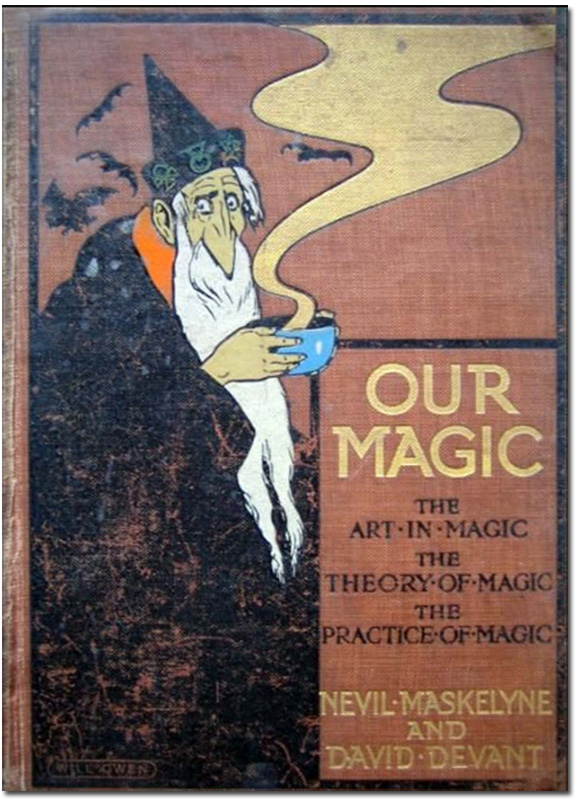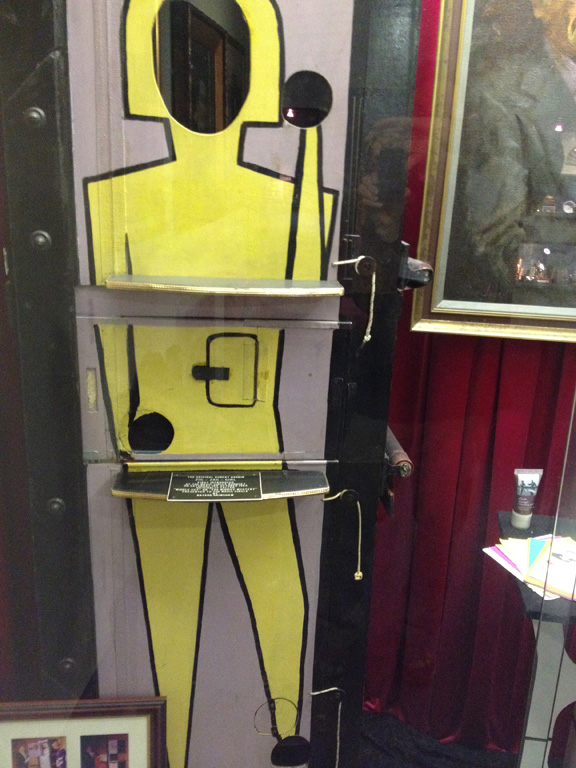|
Although I am still limping along on my first-edition iPad, I remain astounded at what a delightful portable magic library it has become. There are now four iPad models from which to choose along with the surprisingly seductive iPad mini, not to mention the competing tablets, all of which can hold tons of terrific magic, both ancient and modern. The explosion of available titles has recently been fueled by offerings from Todd Karr's The Miracle Factory and by Louis Falanga's L&L Publishing. Although both consistently offer great texts at fair prices, they frequently offer outstanding texts for outstanding prices, less than ten bucks, just incredible. This month we'll take a retrospective look at two such offerings, Our Magic by Maskelyne and Devant (the 1911 version which many of you have never seen), and Simply Simon by Simon Lovell. Both books were reviewed way back in 1997, in the "British edition" of The Little Egypt Gazette, and the original reviews are reprinted here. I beg you to excuse the dated references and the stylistic excesses of my younger self. (By the way, since the initial reviews, I've had the great pleasure of performing Simon's Double Trouble, in the book. It's a faux mindreading code that will drive your audiences crazy.)
OUR MAGIC (NEVIL MASKELYNE AND DAVID DEVANT) -- My home town library's edition of Our Magic looked (still looks, actually, as I now own it) more
like a magic book than any other book I've ever seen. Its cover is a rich brown cloth, and,
although the binding has been replaced with a stock library binding, replete with the Dewey
decimal 793.8, the cover still clearly conveys the image of a Merlinesque figure holding a
steaming bowl of something, with bats fluttering about his head. The three principal sections of
the book, "The Art in Magic," "The Theory of Magic," and "The Practice of Magic," are
prominently displayed along with the authors' names, Nevil Maskelyne and David Devant.
(Maskelyne wrote the first two sections, Devant the last.) It's a surprisingly heavy book for its
size, no doubt because of the weight of the 505 glossy pages within.
Although magic knew only one David Devant, it knew three Maskelynes, so perhaps we should
clear up which one wrote this book. The eldest was J.N. Maskelyne (the J.N. stands for John
Nevil, but he went by his initials in magic circles). Originally a watchmaker, he and his friend
George Cooke attained a certain fame by debunking the fraudulent spiritualist Davenport
Brothers. This led to a few years as traveling magicians, until J. N.M. and Cooke purchased
Egyptian Hall in London, which became England's Home of Mystery for 30 years. J.N. bought
St. George's Hall in 1904, at which time Cooke dropped out in favor of Devant. When Devant
eventually retired in 1914, J.N.'s son Nevil joined the partnership. By this time a third
Maskelyne, J.N.'s grandson Jasper, had already appeared on stage with Devant (he was nine
when Devant used him as a prearranged "boy from the audience" for his famous egg trick). It
was the middle one, Nevil, who wrote Our Magic along with Devant in 1911. Nevil's sections
grew from articles he had contributed to The Magic Circular, house organ of The Magic Circle,
while Devant's section describes in great detail the routines from an act that made him one of
the most popular magicians of his time.
I should elaborate that the volume described so far was one of the earliest editions, published in
London by George Routledge & Sons, Limited, and in New York by E. P. Dutton & Company.
The book eventually went out of print and, after lying fallow for several decades, resurfaced in
1946 as part of The Fleming Magic Classic Series. The Fleming edition dropped the Merlin
figure from the cover and inserted line drawings for what had previously been photographic
plates.
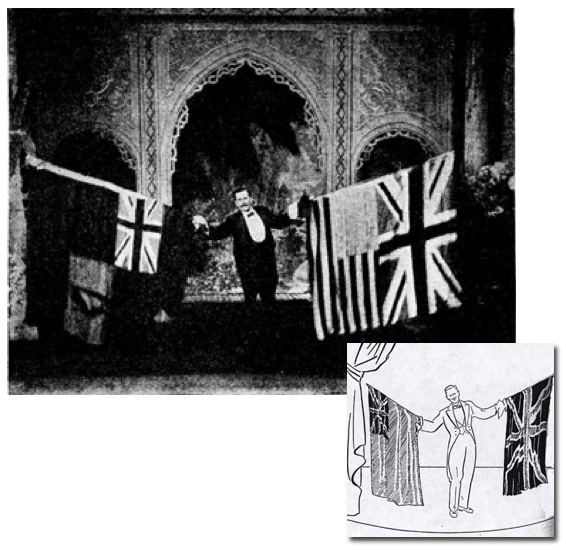
Devant's "The National Colors," Routledge & Sons edition (upper), Fleming edition (lower)
|
But how did this physically heavy and technically ponderous volume affect me as a boy?
Primarily, it was not only the first book I encountered that ran to 505 pages, but it was also the
first magic book I encountered that took itself so seriously. In "The Art in Magic," Maskelyne
lays out 24 rules with great authority. Until then, my contact with magicians had been one local
fellow who wanted to be a clown as much as a magician, and another who would not really
progress past Mak Magic effects. That an adult could utter such a phrase as "When Magic and
Drama are combined in one presentation, the stage procedure should primarily be governed by
the dramatic requirements of the case, rather than by the normal principles of Art in magic" was
a revelation. As a boy I hadn't the foggiest idea of what the rule meant, and I'm not much
more certain as an adult, but I knew it was a hell of a cool thing that Maskelyne said it, and that
he laid it out as a commandment. These rules were incorporated within lengthy essays,
followed by a section attempting to break magic down into various scientific categories, and
then by all those photos of Devant and his apparatus on the St. George's Hall stage. Taken
together, these three sections made me realize that there was far more to the study of magic than
I had yet guessed.
Of course not everyone heeded Maskelyne's teachings. There were cries of not being able to
"plough through all that stuff!" and "In any case, I don't agree with all of it." Similar cries have
met more modern books on theory, including the works by Eugene Burger and Darwin Ortiz,
Michael Close and Tommy Wonder. (I am convinced that virtually any rule in magic can be
countered by its opposite, and that the opposite can work. "Learn only six tricks," the pundits
say. "Learn them all!" Michael Skinner might counter, and it's worked for him.)
As to the rules in Our Magic, a few have remained quite popular and are oft-quoted:
Always endeavor to form an accurate conception of the point of view most likely to be adopted
by a disinterested spectator.
And:
Never perform, in public, anything that cannot be performed with the utmost ease in private.
If you don't have a copy of Our Magic, you can find all 24 rules at Martin Lewis's web site,
accessible from our "Favorite Links" page. As an adult, I find the book a trifle stuffy, and the
rules a bit repetitious. I prefer more modern writings on magic. But I still get that old thrill, as
Vernon did with the rules in Erdnase, to find these concepts laid out as rules, and with such an
air of importance.
Our Magic, by Nevil Maskelyne and David Devant. 1911 edition, made available by the Miracle Factory. 503 pp. $9.99 in e-book format.
|
SIMON SAYS! THE CLOSE-UP MAGIC OF SIMON LOVELL -- Simon Lovell is a card hustling, dice stacking sleight-of-hand artist whose performance material
is out there on the fringe, a la Tom Mullica and David Williamson. (One assumes he is more
subdued in a poker game, but that's an issue for another day.) Raising Tom Mullica's name
here is doubly intentional, because Simon Says is one of the first books I can remember since
Show-Time at the Tomfoolery in which all the material consists of strong performance items.
(The new book grew, in part, from Simon's Blackpool 1995 lecture notes, for which the patter
was recorded at Mad Murphy's bar in Hartford.) Books like this are tough on a reviewer.
Which items do you single out?
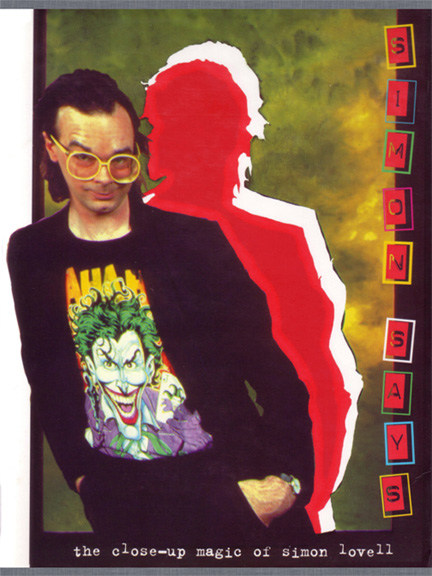 Simon in hardback, now e-book. Simon in hardback, now e-book.
As Simon notes early on, "You are probably starting to get the idea that I like very weird patter
lines!" The wildly outrageous scripts that accompany the 50 or so items in this fat new book
certainly confirm that observation. Although full scripts are provided, this doesn't mean that you
can perform them verbatim, unless you are fortunate enough to be Guy Hollingworth or Hugh
Grant. Simon comes from Manchester, England, and he therefore talks funny. He calls
spectators chaps, and he uses such terms as all jiggery-pokery. I'd draw strange glances
indeed were I to utter such words in a Little Egypt bar. But the engaging story lines hold up, and
it shouldn't be too difficult for you to translate them into your local argot. (If one must use
British terminology for spectators, I always preferred The Crimp's Jerry Sadowitz's term, spekky
bastards. But that too would fail to play well in most of my venues.)
Simon Lovell's professional experience with close-up magic is rather specific: it is either table
hopping or walk-around. These conditions impose rather strict requirements on an entertainer in
terms of people skills and performance material. Simon addresses the people skills in Part One
of the book, "The Thoughts of Chairman Lovell." Here he rigorously examines how to
approach, entertain, and leave small groups; how to successfully invade comfort zones; and the
subjects of routining and resetting, tipping (he's against), taking advantage of flukes, and how to
diagram the entertainment value of a card trick. As to material, Simon's performance venues
demand a certain practicality, and you will therefore find more to recommend this material than
its considerable entertainment value. He is for direct effects, against borrowed items, for give-aways, against any significant resetting, and for vertical magic over tabletop items such as ace
assemblies (what Paul Gertner calls "up" effects, or up in the air off the table). Simon's
situations don't allow close-up cases and close-up mats. The magic takes place in his hands and
in the hands of his spectators, and it comes from his pockets.
"Sleight of hand is only practice . . . ANYBODY can do it given time and dedication." -- Simon Lovell,
Blackpool 1995 The Simon Lovell Lecture
Those of you who know Simon from his various card shark videos know him as a highly-skilled
sleight-of-hand expert and may harbor fears as to the degree of difficulty of the effects in this
book. Don't despair. There is a chapter titled "Sleight of Hand Goodies," and it does contain
some upper echelon card work. I confess I spent a bit less time with this chapter than with some
of the others. But if you want to put in the work, this chapter is there for you, and Simon takes
elaborate pains to make the difficult possible. I am thinking here in particular of Simon's
elaborate treatise on "The Push-off Second Deal" in this chapter. There are other moves, far
easier, sprinkled throughout the book, including "SloMo Pass," "Super Quick Simey Fold" (a
very nice Mercury-type card fold), "The Simey Sloppy Card Fold" (a fold done in your mouth!),
"The World's Easiest Riffle Force" (it is), and "Squelmsley Count" (an Elmsley in which one of
the cards is not seen twice). One of my quibbles with the layout is that some of these practical
moves were not highlighted in the table of contents, as they were in The Classic Magic of Larry
Jennings.
"We've run the whole gamut from self-working to difficult and from sensible to totally insane. I
really believe that there has been something for just about everybody!"
-- Simon Lovell, "Final Simey Words," Simon Says
For the rest of us, as Steve Jobs might say, there is an abundance of astonishing magic in the
remaining chapters -- "Openers, Middlers, and Closers" "Sitting Specials and Other Bits,"
"Gaffed and Faked," and "Gags, Stunts, and Other Bits!" Some of the best material is in fact self
working, and you will have a difficult time not adding some of this stuff to your repertoire. The
first of these chapters meets Simon's criteria for walk-around and table hopping, the second
contains material for seated situations, the third uses simple gaffs, and the last holds such
weirdness as the pen through tongue and the rising cards from a glass of beer, sort of.

"Simon is one of the many guest performers that I've invited behind the bar including J.C.
Wagner, Bob Sheets, Johnny Thompson, John Carney and even the late Fred Kaps. Yet I've
never seen anyone get the reaction that Simon received that evening."
-- Scotty York
As mentioned above, all the material is strong, practical, real-world stuff. The following items
therefore are only representative effects that I liked, the tip of a rich card trick iceberg.
Another Departed Point -- Probably the best version of this type, from the famous Elmsley
plots "Between Your Palms" and "Point of Departure." Three cards are selected and found, but
the killer is that a spectator's signed card turns out to be the card placed under another
spectator's hand before the effect begins. Available in this issue if you know the secret word.
Predicted Bermuda -- Spectator mixes a red deck behind his back and removes three cards.
Magician removes a blue deck and shows three cards to be reversed. These match the
spectator's cards.
Hold the Mayo -- A very effective three-phase sandwich effect. The red kings repeatedly
sandwich the spectator's signed card, in increasingly impossible ways.
Sleight of Mouth -- This has to be the wildest card from mouth routine on record. Simon starts
with the entire deck in his mouth.
Who Killed Lilly Longlegs? -- A "Sam the Bellhop" effect with a great script and all Simon's
thinking as to how to make this play. All you do is turn over the cards and say the words. But
over the years, in the real bars of the world, guys like Frank Everhart and Eric Mead and Bill
Malone have killed with this stuff, and so has Simon, who teaches you how. He uses it to close
his small parlor shows.
The Lemming Ace Exchange -- Based on a Roy Walton plot, a spectator's card changes places
with a jumbo ace. One of the craziest patter stories in the book, with the magician breaking
down and weeping.
Impossible Location -- Just a deadly mental effect, or at least that's how I would present it.
Magician turns his back, and spectator deals cards onto the table. She stops anywhere and looks
at her card. She then regroups all the cards, any way she pleases, and shuffles the deck,
repeatedly if she wishes. Magician now turns around for the first time and instantly knows her
card. She can examine the ordinary deck until the next issue of The Braue Notebooks appears,
and she will find nothing. No stooges, no hidden cameras, just you and her. She should now be
putty in your hands.
Ambitious Everywhere and Nowhere -- One of my favorites in the book. Paul Gertner features
an effect called "Paul's Opener," in which he repeatedly forces the same card on a spectator.
This effect is like that, but with a much stronger and more physical interaction with the
spectator. More of a bar trick than a corporate trick, but if bars are your milieu, this effect is
ideal.
Challenge Reverse! -- Involve as many spectators as you wish. Let ten of the spekky bastards
(excuse me, chaps) take a card. The cards are very cleanly returned to the deck and the deck is
fairly squared. Magician slams the deck between his hands but fails to find any of the cards,
much less all of them. He salvages the moment by causing all the chosen cards to reverse
themselves in the deck. Oh so easy.
Elmsley Cut Elmsley -- The toughest routine in this list and possibly the book, and the one
Simon uses to close his Magic Castle act. A spectator puts the 13 clubs, for example, in order.
These are randomly distributed into a spread deck. Spectator chooses another card, such as the 7
of hearts, and this too is lost in the deck. Magician now begins dealing cards in a line, from the
top of the deck. Surprisingly, the cards are the clubs back in numerical sequence. The seventh
card is left face down as the dealing of the suit is completed. The face-down card is turned up
and found to be the 7 of hearts. The 7 of clubs is removed from the magician's pocket.

Although Simon Lovell has numerous routines published in magazines and anthologized in
books, along with other dealer items, books, manuscripts, lecture notes, and videos to his credit,
this is his first major hardcover, and no doubt the reason he has been so generous with its
contents. The cover photo is a typically striking Anne White photo, and the book is extensively
illustrated with Hannah Ammar line drawings. I'd have preferred it to be extensively illustrated
with photos of Hannah taken by Anne White, but one can't have everything. Simon apparently
travels in the company of a photographer, as there are also numerous photos of him in the book
in the company of such magicians as Randy Wakeman, Father Cyprian, Steve Beam, Terry
Seabrooke, Mark and Nani Wilson, Howie Schwarzman, David Acer, Obie O'Brien, Jack Avis,
Guy Hollingworth, Derek Dingle, Shelley Carroll, Johnny Thompson, Roy Walton, Larry
Becker, Tom Mullica, Billy McComb, Penn and Teller, Bob Read, Tommy Wonder, Todd
Robbins, Scotty York, Jim Sisti, Milt Kort, Milt Larsen, Frances Willard and Glenn Falkenstein,
and Jay Marshall. (Simon is no fool: that's at least 28 guys who are going to buy the book!)
In addition to Simon's Introduction, there is additional frontal matter by Randy Wakeman,
Father Cyprian, Walt Lees, and a very funny page by Scotty York, plus a page of bottom matter
by Terry Seabrooke. Regarding the trick matter, the book is quite easy to navigate. Each item
begins with a brief History/Comments paragraph, followed by a succint description of the Effect,
and then on to the Method and Routine. Along the lines of Harry Lorayne "Afterthoughts,"
Simon also liberally includes such asides, as DURINGTHINKS, AFTERTHINKS,
OPTIONALEXTRALINETHINKS, PUSHTHROUGHSHUFFLETHINKS, and so on. Overall,
the book is a lot of fun to read. There is an air of infectious good humor in it, not only in the
scripts, but in the numerous helpful asides.
Simon Says! The Close-up Magic of Simon Lovell, by Simon Lovell. Published by L & L
Publishing. 242 pp. $22.95 in e-book format. Only $9.95 through November 2012.
|
|
GENII'S DIAMOND ANNIVERSARY ISSUE -- As I mentioned previously, reviewing the September 1960 issue of Genii, "for a magazine that had been averaging 36 pages, Genii's 104-page silver anniversary issue with its shiny cover was a whopper of a surprise." It was a similar thrill to receive, digitally first, the 196-page Diamond Anniversary issue of the magazine.
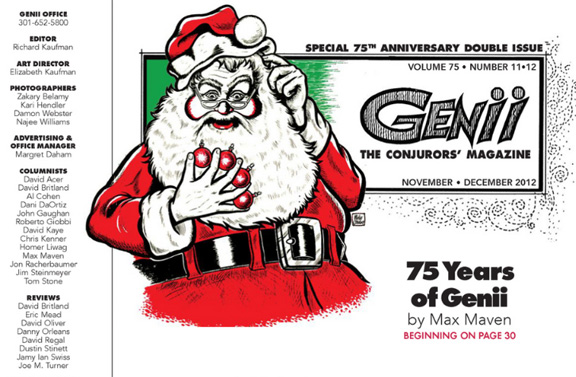 Mickey O'Malley once again graces the Genii frontal matter. Mickey O'Malley once again graces the Genii frontal matter.
With the exception of its usual "Genii Speaks" and "On the Slant" columns, and an Alan Shaxon obituary by Matt Field, Richard Kaufman turned the entire monster issue over to an expanded history of Genii by Max Maven featuring a Jay Marshall-esque 69 tricks. Both the history and the tricks are stunning. Max gives a behind the scenes, in-depth look at not only the magazine but at what was happening in magic in general, decade by decade, encompassing 75 years. For many of us, this is the story of our lives. As for the tricks, this is for many of us also the repertoire of our lives, with card tricks ranging from a Larsen and Wright spelling trick in 1940 to Christian Engblom's near impossible Anti-Faro in 2001. It was in Genii that I first encountered "professional" magic tricks, material that transcended that found in the beginner books of my small town library, and Richard's sampling is generous, with parlor and illusion material, a bounty of material from Charlie Miller's "Magicana," and all six installments of Steranko's "Room 477 Card Workshop." (Richard even performs one on video, Matt Corin's color change, which always intrigued me but I didn't think it was practical; how nice to be proven wrong!)
 Steranko returns to Room 477 ... on an iPad. Steranko returns to Room 477 ... on an iPad.
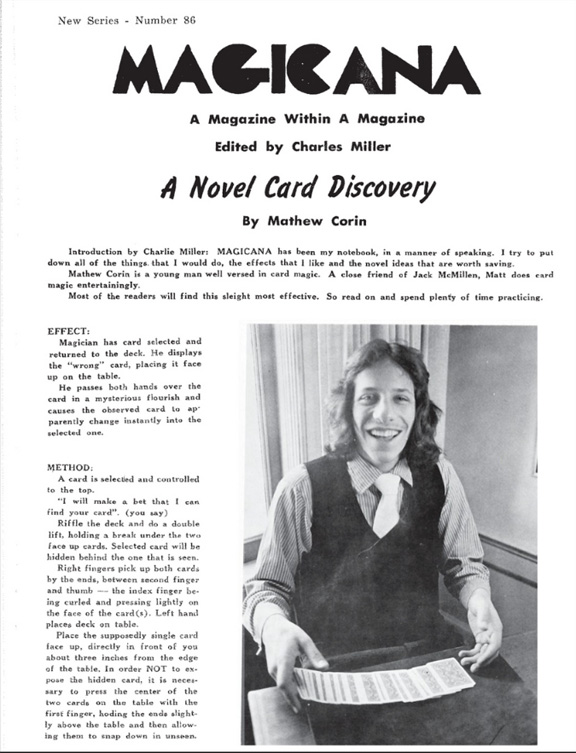 Magicana as you've never seen it! RK demos this on video! Magicana as you've never seen it! RK demos this on video!
As always, Liz's layout enhances the reading experience enormously, beginning in this issue with a retro Mickey O'Malley cover and guiding us through Max's history with top and bottom borders composed of thumbnail covers. For us longtime readers, the entire issue is a delightful trip down memory lane. (If you are not a subscriber, you have a lot of catching up to do! The entire Genii file, all 75 years, is available online to subscribers, free! There is no better time to get started than with this mammoth anniversary issue.)
|
|
FROM FRANCE, WITH LOVE -- Had I posted this issue last night, as I intended, I would have missed this story entirely. This morning I received unexpected email from Vincent Hedan, whom I hadn't heard of before, but that is my own fault for not getting around. Vincent was at 4F in 2011, and he competed for France in the recent FISM, so he has already been making quite a name for himself. The email advised me of his newly updated web site, which is beautifully designed to introduce both Vincent and his lovely products. Those that struck me as tantalizingly special were Multitude (a book that details tricks for a special Multieffect deck, featuring video card trick performances that fooled me badly), the 10,000 Decimals of Pi (with which you demonstrate that you have memorized pi to 10,000 places), and Babel (with three paperback books you perform any of the killer book tests you are familiar with).
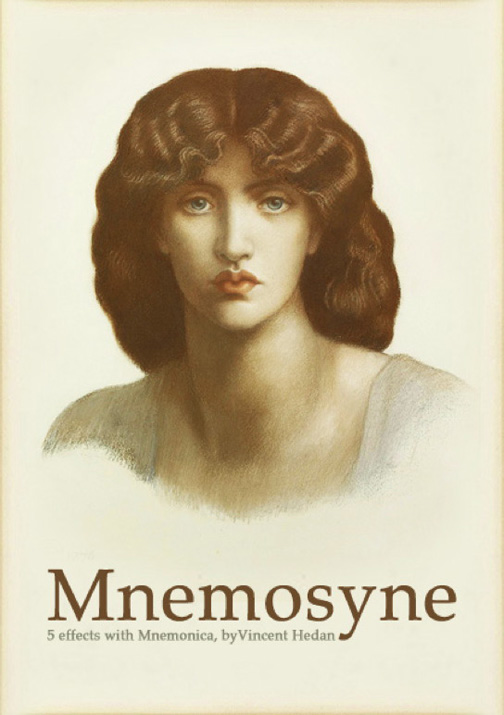 Free from Vincent Hedan. Free from Vincent Hedan.
As an exceedingly generous get-to-know-me gesture, Vincent offers a free .pdf called Mnemosyne, a five-trick sequence using a modified Tamariz Mnemonica stack. You needn't memorize the stack or even know it (the necessary stack is provided). The tricks are really strong and it seems, as you progress through them, that a stack is totally out of the question as the cards are dealt, cut, rearranged, etc. In short, here is a strong close-up act for free. As Vincent's ads proclaim, "Creative Magic, Impossible Effects, Easy Methods." I'll say! Check him out.
|
|
GET REEL -- Issue 30 of Kozmo's excellent reel magic DVD-zine is at hand. Is it just me, or does this issue seem packed with more goodies than usual? I loved Jon Armstrong's introducing a cool move demonstrated by Richard Kaufman, Silly Billy's intro to the Coloring Book trick, Slydini's touch on the Hindu Shuffle (taught by Bill Wisch), Simon Lovell's not quite a rant (this time on the need for brick and mortar shops), and featured interviewee David Stone teaching a beautiful rope routine.
 Chad works on his dribble force. Chad works on his dribble force.
It's for none of these good reasons that I bring the issue to your attention. Rather, still coming down off the high of the Genii bash, I am more than pleased at any opportunity to see Chad Long work, and two such opportunities appear in the context of David Regal's Tricks of the Trade column. Here you get to see Chad working for real audiences, demonstrating his book test Spineless and his card trick Now Look Here! Watching these brief clips is a study in how to make a book test or a card trick entertaining. Very few seconds go by without Chad getting another gag in, all relevant to the action and apparently spur of the moment fresh. Whatever, as usual, it was a fun issue to watch.
|
|


